Have you ever sat on the yellow sand, staring at the beautiful waves of the ocean? You watch different people. The kids splash water by the shore. Some beachgoers set up their umbrellas. A lot are swimming farther and farther away. And most interestingly, a few are riding out the waves with their paddleboards.
You stop and look at them for a long time. “What if I was out there with them?” you ask yourself. “Where do I start?”
You start your stand-up paddle board surfing here, of course! I’ll fill you in with everything you need to know about the watersport here, including its history, how it works, how to gen into it, its health benefits, an essential checklist, and of course, the step-by-step guide you’ve been waiting for.
Lucky for you, stand-up paddle board surfing is my favorite watersport! And the community has been nothing but spectacular! But before we get into that and the nitty-gritty, let’s start with its history.
Where Did All of This Begin?
The roots of paddleboarding branch back to as far as 3000 B.C., when Peruvian fishermen rode a watercraft called Caballitos de Totora for fishing. Back then, the vessel was made out of reefs and propelled by bamboo shafts. (Spoiler alert: paddleboards can be used for the same purposed thousands of years later!)
Flash forward to 1778, Captain James Cook discovered the Hawaiian Polynesians. You could say that they were some of the world’s first surfers. How? Well, wave rising was a core of their culture. Their chief was the most skilled wave rider, so he possessed the best board and a long paddle. Yes, they skillfully carved those waves even back then!
By the 1950s, the practice of standing up on a surfboard with a handheld paddle had its hold in Hawaii. This came to be once the Waikiki beach boys needed to breathe new life into the sport. It was thanks to the surfer John “Pops” Ah Choy for such a feat. After they found him surfing on an oversized surfboard and a paddle, they knew that paddleboarding should have a spot on their beautiful waters.
But, the practice died down for a few decades. By the 21st century, it rose to popularity once more. This was due to famous surfers Dave Kalama and Laird Hamilton shredding the waters of Maui with paddles and longboards and paddles. They were even photographed while doing just that!
By then, stand-up paddle board surfing took its spot in the long list of watersports beachgoers can enjoy! SUP has branched out into a lot of types since then. And one of those types is surfing!
Now, that you know its history, let’s talk about how you can get into it!
How Fit Should I be to Surf?
Worried about the criteria needed for stand-up paddle board surfing? Well, I’ve got good news for you: there are none! People of all ages and fitness levels can get into this sport within just a few hours. With its easy learning curve and some proper instruction, you can actually ride those waves in no time!
So, are there Any Health Benefits?
If the flexibility of the sport has sunk its hooks on you, then here’s another thing coming! If you’re wondering if Sstand-up paddle board surfing is a fun, refreshing exercise, then you’re absolutely right! Everyone can benefit from this low-impact workout, that targets your core, back, arms, and legs. It engages your full body and trains your balance, strength, and endurance all at the same time.
So, yes, it definitely has a positive impact on your health! Aside from burning all of those calories, here are several health benefits that can pull you in a bit more.
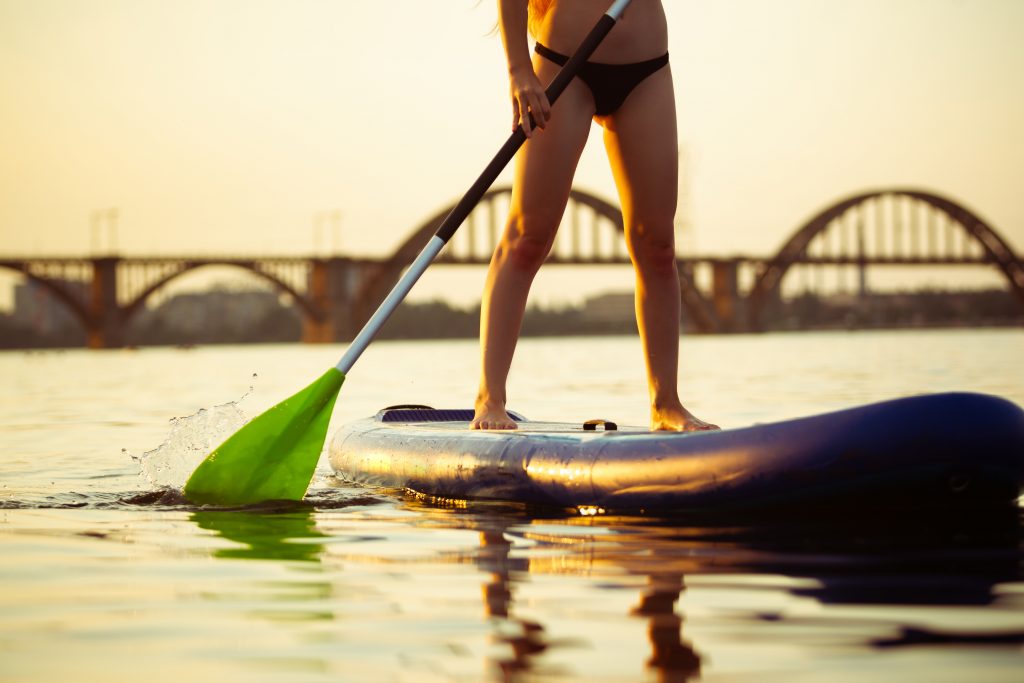
Get (Or Stay) in Shape!
As I’ve said, stand-up paddle board surfing is a full-body workout. It engages your core, back, and leg muscles all throughout your journey. This is due to the constant need to maintain both dynamic and static balance. All said muscles work while you’re standing and while you’re making the sharpest turns.
Not only that, but it also tones your arm, back, and shoulders as you steer your board with a paddle. Your upper body is essential in navigating the waves after all! So, you can expect to burn a lot of calories while improving your whole body strength, balance, and endurance.
Relieve That Stress!
It’s no secret that most days can get really hectic sometimes. Sometimes, you just need a break from all of your stressors. Maybe stand-up paddle board surfing can give you just that! Aside from the water’s calming qualities, the workout can actually reduce the body’s stress hormone. Plus, it increases the production of endorphins, the body’s natural painkillers and mood elevators.
So, the next time you need a pick-me-up, consider grabbing a paddleboard and going out into those waves!
Be One with Nature
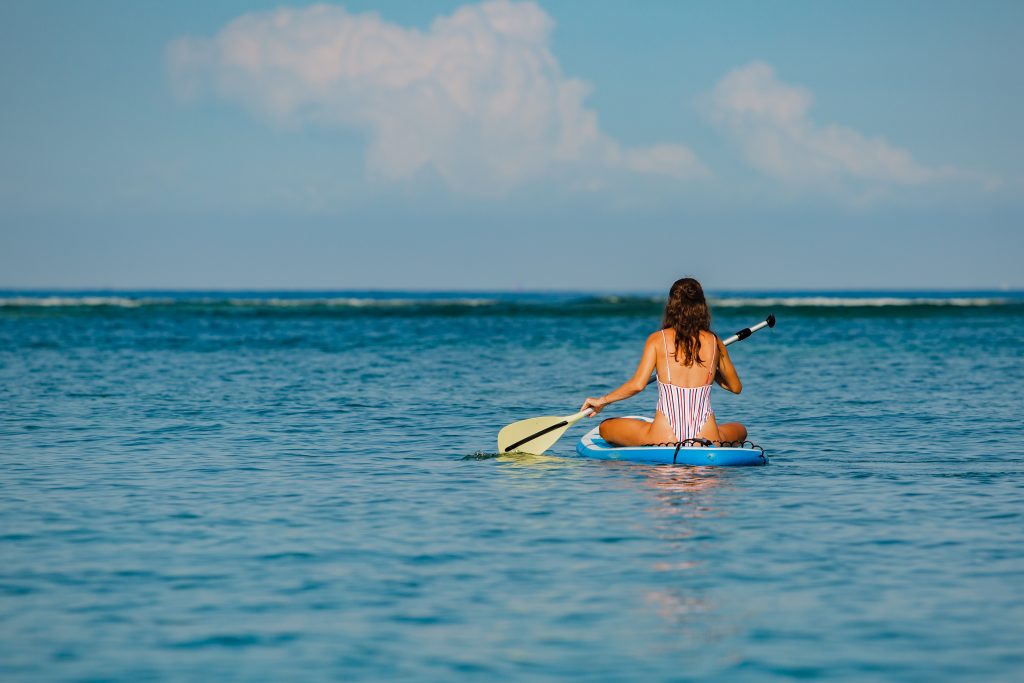
Imagine being linked to your paddleboard, carving the waves. When the waves crash and you wipe out, you get to meet the creatures of the sea. Once you break the water’s surface, you see the beautiful landscape around you.
The possibilities are endless when it comes to stand-up paddle board surfing! You can take your paddleboard almost anywhere the waves rise high. Aside from the burned calories and stress relief, you also get to be one with nature as you surf. Isn’t that cool?
Give that Stamina a Boost!
With the constant paddling, getting back on, and maintaining your balance, stand-up paddle board surfing definitely requires much of your stamina. Don’t be intimidated! As I’ve said, people of all fitness levels can get into this sport–and can gain a lot of endurance after every surfing session! stand-up paddle board surfing is definitely a sport that keeps on giving.
Improve Your Balance
Lastly, you get to improve both your static and dynamic balance. If you found difficulty in standing upright while floating on water at the beginning, then you can expect some significant changes in your static balance later on! And the same goes for your dynamic balance, which is improved as you make those sharp turns and change stances. So, as your overall body strength and endurance improve, your balance definitely isn’t falling behind.
The SUP Surfer Checklist
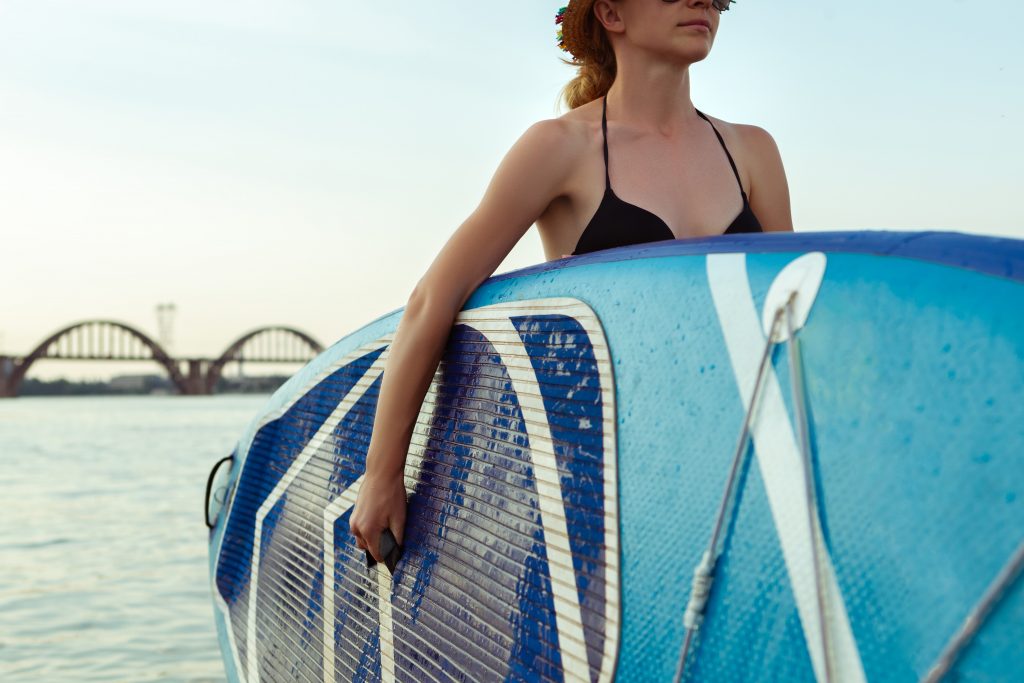
You’ve got the history, the fitness level, and health benefits down pat. So, before I move on to the detailed step-by-step guide to stand-up paddle board surfing, you gotta gear up! I’ve mentioned some of the things here in my previous posts, but I’ve included them here to put you up to speed.
Paddleboard
This is the most important gear in your arsenal. The shape and dimensions of your paddleboard are essential to maximizing your stand-up paddle board surfing session. I’ve divided this into four categories for your reference.
Length
Since there are several types of stand-up paddle board surfing out there, you can expect that there are different types of paddleboards for each occasion. With surfing, I recommend getting a board smaller than what you would use for cruising and/or touring beautiful landscapes. Choose a board that’s about a foot less than your typical paddleboard. This size difference can help you navigate the wild waves better.
Width
In terms of width, choose a board no wider than 30 or 31 inches. Sure, a larger one can give you more stability, but it would give you a harder time in making those turns and pushing through those breaks.
Shape
With shape, choose a sleeker and more streamlined paddleboard for more of that slicing action once you’re out in the water. Search for a board similar to the look of an oversized surfboard and you’re ready to push to climb up those frothy waves!
Weight
With all of the falling, getting back on, and travel, you should definitely get something that’s not too heavy. Here’s a rule of thumb, choose a surf SUP that you can grab by the handle and carry all the way to the water. Be sure that you can lug it around without putting it down for a rest.
Paddle
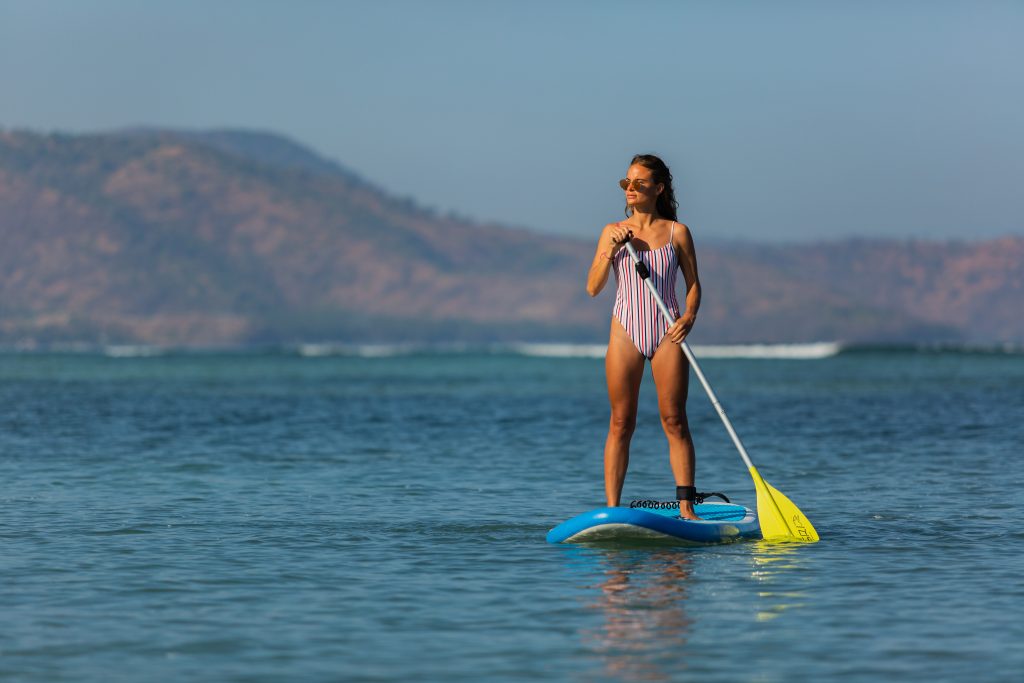
Next up is your trusted paddle. What you need is one that is super lightweight and angled. In my experience, having one would mean an easier time making those sudden turns, and shredding the high waves. Also, get one that is about your height. Sure, you’re going to exert a lot more effort in steering. But, at least you’re gonna get an easier time maneuvering in return.
Besides, you’ll be gaining a lot more strength as you keep on paddling anyway!
Life Jacket
Also known as a personal flotation device, you definitely need this one for every stand-up paddle board surfing trip. With safety being your top priority, you should always have this on you, especially since the coast guard requires all paddlers to wear one. It’s 100x better to be safe than sorry, right? I promise the life jacket would interfere with the fun experience!
Rescue Equipment
Of course, assuring your safety doesn’t stop at having a life jacket with you. Once you’re out in the water, there’s always a chance of getting into dangerous situations. So best be prepared! Have a whistle and a waterproof flashlight with you.
Should you find yourself caught in isolated or rough areas, a whistle might just be what you need in alerting others nearby. And with nighttime stand-up paddle board surfing slowly growing in popularity, bring a waterproof flashlight with you to have both a safe and exciting experience.
SUP Ankle Leash
I’ve mentioned this gear time and time again, but I cannot stress this enough. Get yourself an ankle leash! Not only is this necessary for avoiding any accidental bumps in the head, but it’s also needed to keep your board close to you when you wipe out. (And that happens quite often really.)
Right Clothing
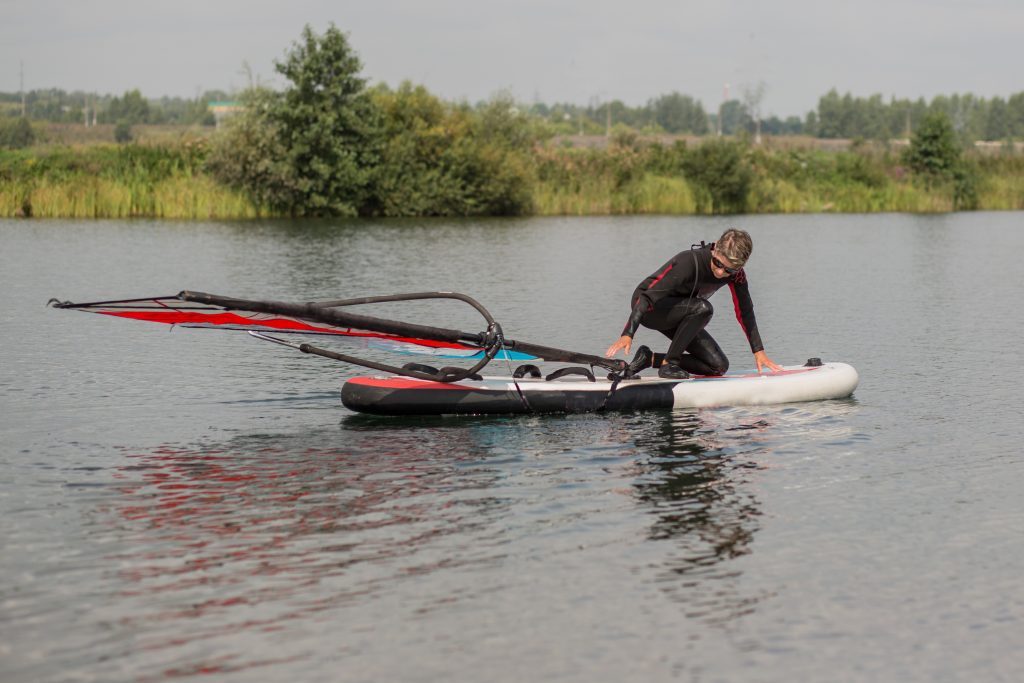
Actually, this varies depending on the location and temperature of where you’ll be surfing. The sun is high and beating down your back, then a comfortable swimsuit should be a good pick! Invited to surf in an area with low temperatures? Get yourself insulated or dry suits! These would prevent cold water from biting down your skin reducing the risk of hypothermia. So best be dressed according to the weather.
UV Protection
Last, but most certainly not least, get yourself some protection from the harmful UV rays. Aside from the danger of the sea, you also have to battle with the sun! So better apply sunscreen when you got out surfing. You can also bring an extra bottle with you–and some water shoes while you’re at it! Better give those legs that much-needed protection.
Stand-up Paddle Board Surfing: Your Paddle-by-Paddle Guide
You’ve finally reached the section that you’ve been waiting for! A paddle-by-paddle (get it?) guide on how to surf with your paddleboard! I know I’ve mentioned some part of this before, but I’ll be taking a more in-depth approach this time around!
Starting with the Basics
I know that learning any new skill can be overwhelming to any beginner, so I’ll make this easy to understand and imagine. I’ll definitely make sure that your stand-up paddle board surfing theory is up to snuff, so you can put it into practice very soon!
Let’s Stand up on that Paddleboard
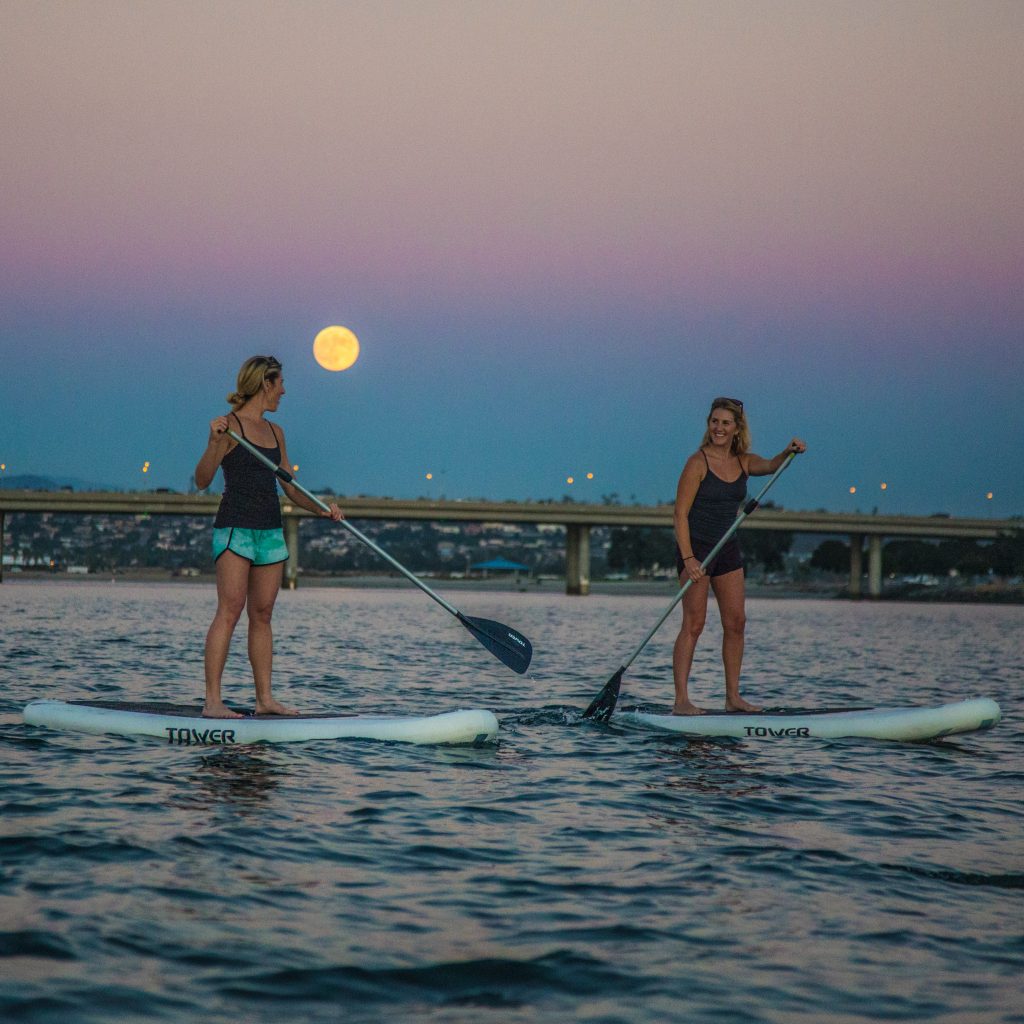
There are two ways to stand up on your board. This One involves kneeling:
- Stand beside the board in about knee-deep water. Make sure that the board’s finds don’t hit the bottom.
- Grab hold of the board’s edges and work your way onto the board. You should find yourself in a kneeling position just behind the center point. You can find the center point through the carry handle.
- Place your hands on either side of the board for stability. Move one foot at a time until you find your feet where your knees were.
- Raise your chest while your knees are bent. Once your chest is vertical, stand up slowly.
Obviously, the Alternative involved no kneeling as you stand up. This one is perfect if you’d like to have that surfer vibe from the get-go! Isn’t this cool?
- Sit on your board.
- Bring your feet under you to pop up.
- Place your paddle down across the SUP in front of you.
- If your board is smaller than usual and/or there are choppy winds, stand up as quickly as possible like a jack-in-a-box! Start paddling right after. You might find your balance more easily.
Keep Your Balance
Now, the water definitely won’t stay still once you’re up on that paddleboard. You might find some trouble finding your balance at first. Don’t worry. I’ve got you covered with these steps.
- Stand with your feet parallel, hip-width apart, and centered between the board’s edges.
- Keep your toes pointed forward, knees slightly bent, and back straight.
- Your head and shoulders must be steady. Stay upright. Shift your weight through your hips.
- Focus on the horizon. Avoid staring at your feet.
And Know Your Stance!
The task of balancing on your paddleboard doesn’t stop there. You’re going to face a lot of wild waves and choppy winds once you’re out there surfing. So learning and maintaining a surf stance can help you build a solid foundation for the sport. Plus, you might find the wave-riding and paddling experience much easier once you get the hang of it!
Here’s what you need to do:
- Start with your feet parallel, hip-width apart, and centered between the board’s edges.
- Place your one foot in front of the carry handle and the other about two feet behind it. Move front and back on your board until comfortable.
- You can switch the position of your feet and try out different surf stances. You can do this until you find the natural placement of your feet.
- TIP: When paddling, take a stroke and you move your feet at the same time.
Hold that Paddle Just Right
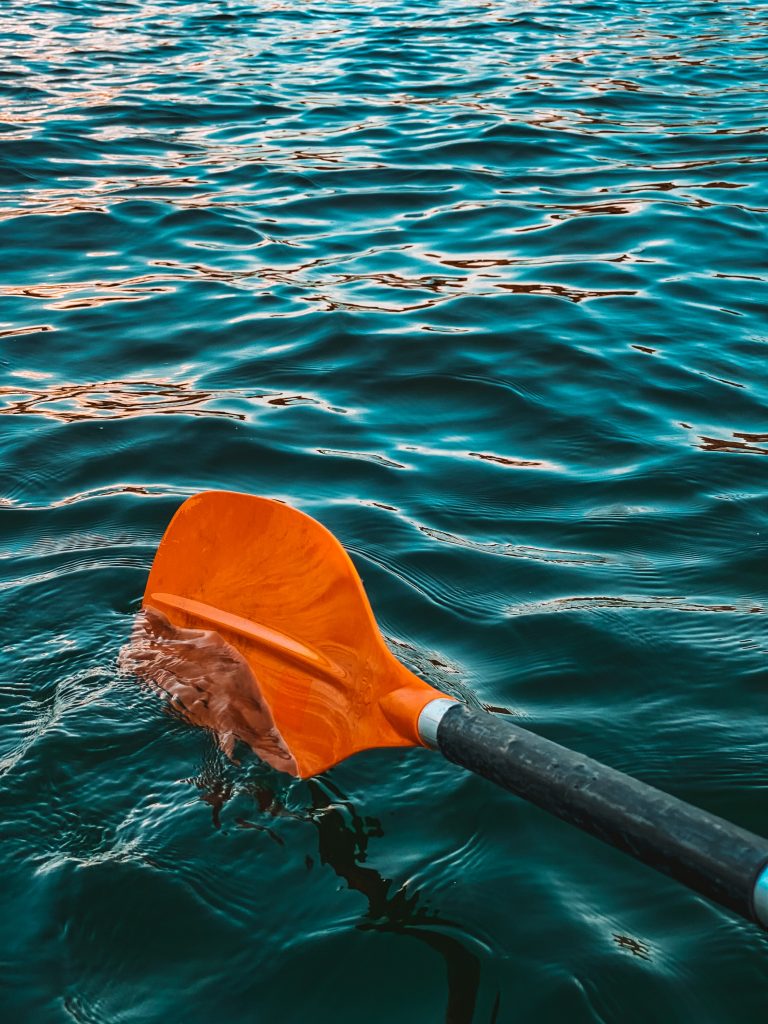
It’s pretty common for beginners to hold their paddle the wrong way, so here’s a short guide on how to do that properly. Of course, it’s going to take some practice before you get the hang of it. But you’re off to a good start here!
- Angle your blade forward, toward the nose of the board.
- When you’re paddling on the right side of the paddleboard, place your left hand on the T-grip and the other a few feet down the shaft. Reverse those hand positions once you switch sides.
Fall, Then Get Back on
Once you’re out there, you’re bound to fall despite your best efforts in keeping your balance. But the important thing is to get back up, even if you’re wet and a bit tired.
So, here’s what you gotta do whenever you take a sudden splash:
- Aim yourself to the side, so that you fall onto the water instead of the board.
- Try your best to hang onto your paddle while falling. If it floats away, retrieve your board first and get back on. Paddle with your hands towards your paddle.
And remember these steps as you heave yourself back on your SUP:
- Position yourself next to your board, near the center.
- Grab the handle at the center of the board with one hand.
- Relax. Let your legs float up to the surface. Kick those legs as you pull the handle.
- Slide yourself back on your board.
Paddling on
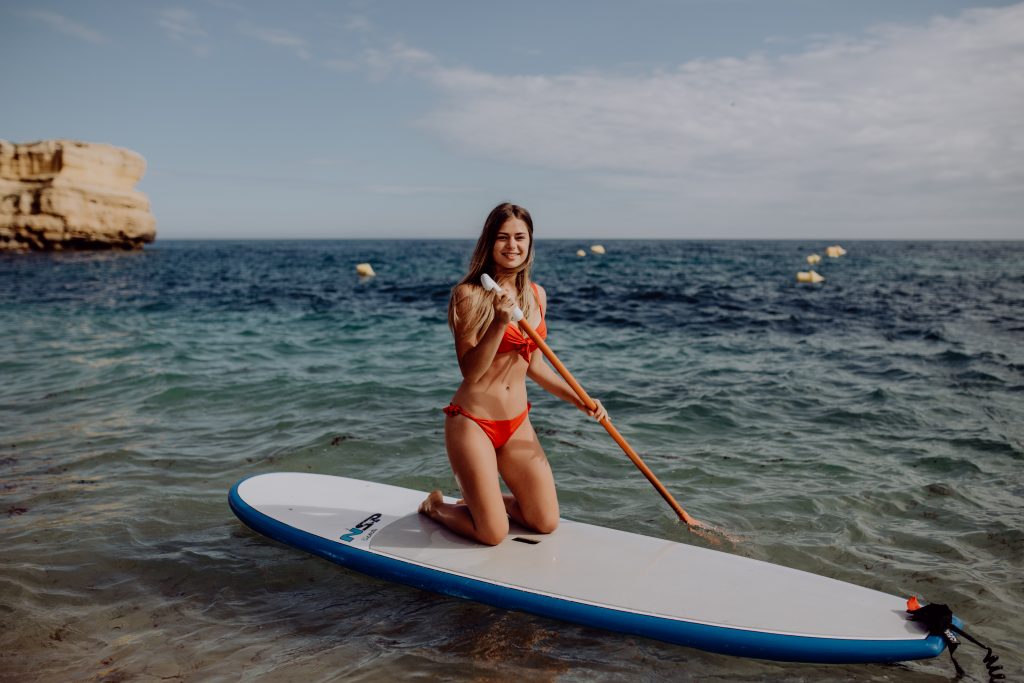
Now, that we’ve breezed past the theory and the basics, let’s get moving! Paddling is what you need to get to the exciting waves up ahead, so keep these techniques in mind, okay?
Forward Stroke
- To propel yourself forward, plant the paddle about two feet in front of you. Push the blade all the way to the surface.
- Move the paddle all the way back, through the water, your ankle, then out.
- Keep your arms straight. Twist from your torso as you paddle.
- Push down the paddle grip with your top hand always.
- Alternate your strokes from one side to the other. Do about three of four strokes on one side. Then switch.
- TIP: The more vertical the paddle, the straighter your path.
Reverse Stroke
This is necessary when you’re slowing down, stopping, or turning. This is the opposite of your forward stroke.
- If you’re paddling on the right, reach behind you. Plant your paddle in the water near the board’s tail. Make sure that the blade is all the way under the water’s surface.
- Again, keep your arms straight. Twist from your torso rather than pulling the paddle with your arms.
- As you do the reverse stroke on the right side, the board’s nose will turn right and vice versa.
Sweep Stroke
This is the stroke you need for turning while standing still or moving.
- If you’re paddling on your right, rotate your shoulders forward. Your right shoulder should then come forward.
- Reach forward. Plant your paddle in the water, dipping it entirely.
- Sweep your paddle away from you in a big arc. It should start from the board’s nose up to the tail.
- Remember to rotate your torso. Use your hips and legs!
- This sweep stroke will turn your board to the left and vice versa.
Here Comes the Fun Part
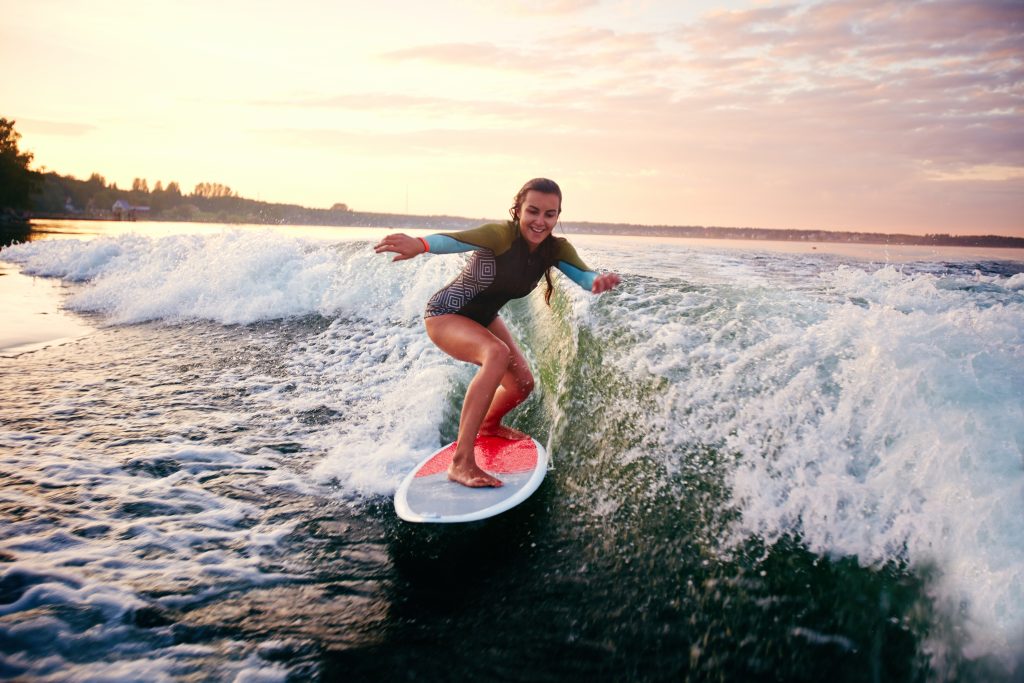
This is actually the best part of stand-up paddle board surfing! You’re facing those waves, about to hit them head-on with all that you’ve got. They can look pretty intimidating, yes, but trust me when I say that you can do this! If you want to build both skill and confidence, then you better remember what I’m about to tell you.
Make Those Hard, Quick Turns
Did you think that the turning stops with all of those strokes? Of course not! Here’s what you needed to when you’re finally high up in those waves, but you gotta make those hard turns.
I’ve got two techniques for you!
The 180-Degree Stand-Up Paddleboarding Turning
- Take wide, circular paddle strokes away from the rail opposite the turning direction.
- Push one foot backward toward the tail while turning. This helps your board pivot.
- Once you’re facing the beach, paddle hard to gain momentum before the wave beats you. Center your weight so the board is floating evenly on the water.
Parallel Turning Technique
Note: This one is a more advanced technique. You can do this to avoid the hard 180-degree U-turn followed by heavy paddling.
- As you paddle towards an incoming wave, turn slightly until you’re parallel to the wave.
- As another wave reaches you, take another hard stroke to turn toward the beach while simultaneously dropping into the wave.
- Never stop paddling! This maintains the momentum of your SUP while adjusting your direction all the time.
Move Past the Breaking Waves
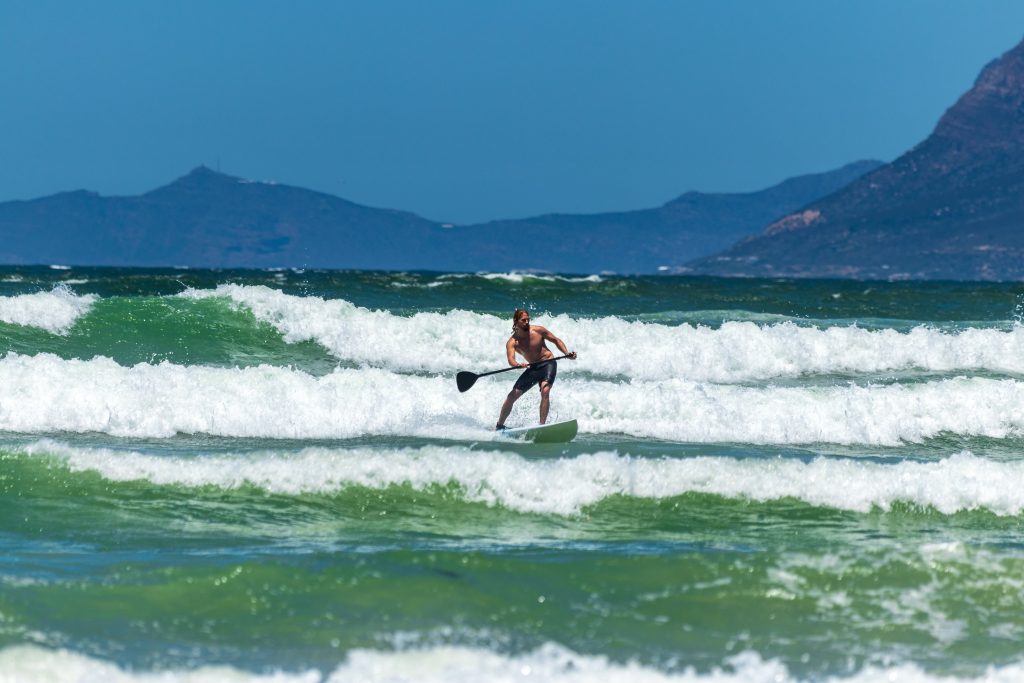
Ready to head out into the waves? A bit hesitant? Don’t fret! Here’s what you gotta once you finally meet the frothy waters.
- Observe the spot. Ask yourself the following questions:
- Where can I enter the water to avoid the big breakers?
- Is there a quiet spot to get to the peak?
- How fast are the waves breaking to try and pass between them?
- Where are the other surfers and what waves are taken?
- Once in the water, paddle vigorously to get past the small breakers, then to the larger ones. You can stay on your board as you get past waves up to your chest.
- Take the surf position. Plant your paddle into the water when the wave hits.
- Press your back foot hard on the tail to lift the nose up until you’re on top of the breaking. Watch your head! (TIP: Put your arm in front of you to protect your face.)
- For larger waves, dive under it while holding on firmly to your paddle. Get back on board once the wave has passed.
- Once you get to the peak, you can take a little pause and observe where you can best take off.
Ride Those Waves
And now you gotta catch them! The great thing is that stand-up paddle board surfing is a lot easier than typical surfing since you’re already standing on the board. We’re at the endgame now, so strap in and remember all of this okay?
- Choose which side of the wave you’re going to ride.
- Position your board parallel to the incoming wave. Point the board’s nose toward where you want to take off.
- Paddle towards the side to launch the board onto the wave. This will pivot your board into the take-off position.
- Stop paddling once your board is (finally!) riding the wave.
- Place your paddle flat on the wave to keep your balance. Use your shoulders as you maneuver the wave.
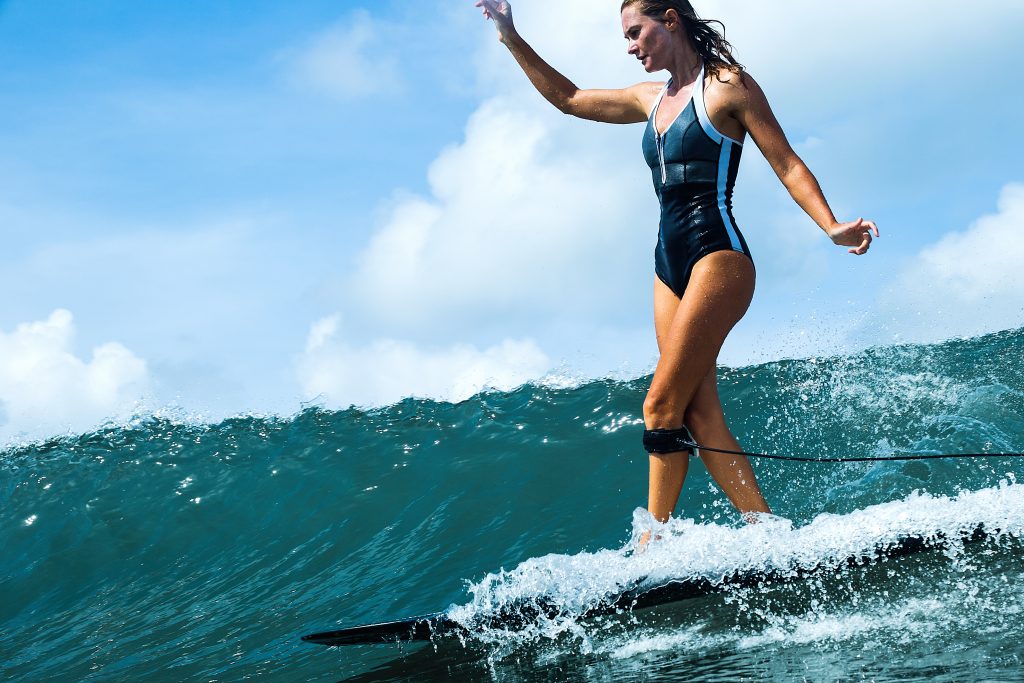
And you’ve finally reached the end of the ultimate stand-up paddle board surfing guide! Congratulations to you! I’ve covered its history, the (lack of) fitness requirement, the overall health benefits. If that’s got you convinced, then you can back to my paddle-by-paddle guide for everything you need to know before you ride the waves. Oh, and don’t forget to bring the checklist with you! I’m excited to welcome you to our always-growing stand-up paddle board surfing community. ?
Want to hear more about stand-up paddle board surfing and the nitty-gritty of it all? Join us on our Facebook and Instagram. We’d love to talk to you more!
Related Posts
Источник: https://standuppaddleboardworld.com/stand-up-paddle-board-surfing/